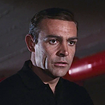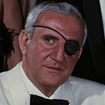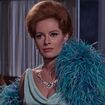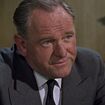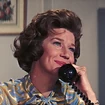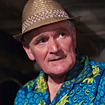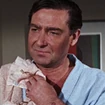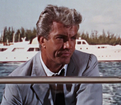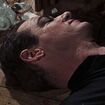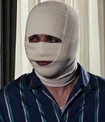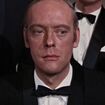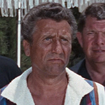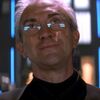- "Aren't you in the wrong room, Mr. Bond?"
"Not from where I'm standing." - ― Fiona Volpe and James Bond
Thunderball is the fourth film in the James Bond film series, and the fourth to star Sean Connery as James Bond. Released in 1965, the film was a critical and commercial success. It was based on Ian Fleming's 1961 novel of the same name. The film was written by Kevin McClory, Jack Whittingham, Richard Maibaum, and John Hopkins and was directed by Terence Young.
James Bond heads to the Bahamas to recover two nuclear warheads stolen by SPECTRE agent Emilio Largo in an international extortion scheme.
Plot summary[]
Like most of the earlier James Bond films, Thunderball is a close adaptation of the Ian Fleming novel with changes mostly for the pre-title credits, the inclusion of gadgets, and an update of technology.
The film begins with James Bond attending the funeral of Colonel Jacques Bouvar, a SPECTRE agent who had murdered two British agents. As it would turn out, a woman who Bond notices opens a car door for herself at the funeral is Bouvar in disguise. Bond comes to this realisation and ambushes Bouvar at his château, where he kills him. Afterwards, Bond escapes using a jetpack to fly to his car parked outside the château where he has a brief battle with his pursuers, during which Bond uses water cannons on the Aston Martin DB5.
A major difference between the novel and film versions of Thunderball is that, in the film continuity, Bond was first introduced to SPECTRE in Dr. No and the events of From Russia with Love are also masterminded by the organisation. The plot of Thunderball deals with SPECTRE attempting to hold the world hostage by hijacking two Nuclear Bombs. In the film, the Avro Vulcan that is transporting the bombs is hijacked by a SPECTRE henchman who has undergone plastic surgery to appear as a NATO observer that would accompany the pilots on the trip. Once in control of the plane, the henchman lands it in the middle of the ocean near the Bahamas where Emilio Largo (number two in SPECTRE) and his men retrieve the warheads and conceal the plane from any sort of overhead reconnaissance looking for it. The bomb retrieval begins after Largo kills the man posing as the NATO observer because he demanded more money prior to the hijacking.
Prior to this event, Bond is ordered by M to attend the Shrublands health farm in order to improve his physical condition. While enjoying a massage from a employee Patricia Fearing, Bond meets Count Lippe, a shifty individual who becomes distrustful of Bond when 007 notices a gangland tattoo on the Count's arm. Lippe subsequently attempts to murder Bond on a traction machine by extending his spine to incredible lengths. Bond faints but is rescued by the attendant (whom he promptly beds); Bond subsequently has his revenge by trapping Lippe in a steam bath, although the count survives. Things become stranger when Bond finds a dead man wrapped in bandages, and survives yet another attempt on his life.
Due to the SPECTRE crisis, MI6 calls an emergency conference where a number of 00-agents are briefed and given assignments (although no faces are clearly seen, this is the first time 00-agents other than Bond have been seen on-screen). Initially M assigns Bond to Canada, but Bond recognizes a photo of the NATO observer as the dead man he saw at the health club. Since the NATO observer's sister is in Nassau, M allows Bond to journey there to investigate. The sister, Domino, is Largo's mistress. Bond exploits this connection to get close to Largo after meeting Domino while scuba diving.
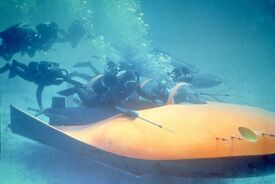
Largo's men battling Bond and the U.S. Navy underwater
An additional character in the film is Fiona Volpe, who is not in the novel. A member of SPECTRE, she was responsible for the substitution of the NATO observer, and assassinates Count Lippe and attempts to kill Bond after rendezvousing with Largo in Nassau. She is later shot in the back by a bullet intended for Bond while dancing at a nightclub with him during local Junkanoo celebrations. Bond leaves her body at a table, saying: "Mind if my friend sits this one out? She's just dead."
Amongst Bond fans it is controversial as to whether or not Bond intentionally moves her into the path of the bullet, Fleming's Bond being against killing anyone in cold blood.
In Nassau, Bond teams up with Felix Leiter and the two set out to find the hijacked plane, which they eventually find along with the corpse of the phony NATO observer. Afterwards Bond informs Domino that her brother was killed by Largo and pleads for her to aid him in finding the nuclear warheads. She gives Bond information that allows for him to take the place of a SPECTRE agent on a mission with Largo, who is retrieving the nuclear warheads from their underwater hiding place, in order to plant one at its target just off the coast of Florida. After an underwater battle that Bond barely escapes from, he is rescued by Leiter from the underwater cave where the bombs were concealed. Bond informs Felix of the location of the bomb, and then he as well as a platoon of U.S. Navy frogmen parachute to the location of the bomb where a massive underwater battle takes place. Bond eliminates numerous SPECTRE frogmen, utilizing various high tech devices, as well as his bare hands. As the battle ends, Largo escapes to the Disco Volante which still has one of the two warheads aboard, and Bond follows, sneaking onto the vessel. Bond encounters Largo, who is attempting to escape by using the Disco Volante's hydrofoil to speed away. The two have a fierce hand-to-hand fight; however, Largo is shot in the back with a speargun by Domino. Bond and Domino jump overboard as the out of control hydrofoil runs aground and explodes. Bond and Domino are spotted by a B17 who throws down a raft and a bag. Domino and Bond get in the raft and Bond throws something out the back of the raft and hooks a tank to it. It turns out this is a helium balloon and a Fulton Skyhook the movie ends with the plane snagging the balloon and Bond and Domino flying off at the end of the skyhook.
Cast & characters[]
Production Crew[]
- Directed by: Terence Young
- Produced by: Kevin McClory
- Written by: Kevin McClory, Jack Whittingham, Ian Fleming
- Screenplay by: Richard Maibaum, John Hopkins
- Music composed by: John Barry
- Cinematography by: Ted Moore
- Supervising editor: Peter R. Hunt
- Production design by Ken Adam
Due to the agreement with Kevin McClory, Albert R. Broccoli and Harry Saltzman are not credited as producers of the film, and are instead credited as the movie being "presented by" them.
Production[]
Writing and Legal disputes[]
Main articles: Genesis and controversies over Thunderball novel
Before being a novel, the story of Thunderball was conceived between 1959 and 1961 as a film screenplay for a James Bond movie which was developed by Fleming, Kevin McClory, Jack Whittingham, Ernest Cuneo and Ivar Bryce[1][2]. The treatments and scripts written during the development of the film has almost all the elements which ended up in the novel and its subsequent film adaptations: the ransom for stolen atomics bombs, the Bahamas, Largo, "Domino", Felix Leiter, Largo's yacht and mansion, the casino, an American submarine, the scientists, and the finale underwater battle[1].
At one point Fleming decided to write the Thunderball novel which was based on the film story element ideas developed by himself, Whittingham, McClory, Cuneo and Bryce. In his novel, Fleming changed the villains of the story from the Italian-American Mafia to a criminal organization called SPECTRE, led by a man called Ernst Stravo Blofeld[1][2]. Fleming also added in his novel all the Shrublands health clinic scenes, which were absents from the film plot[1][2].
The film project never came to fruition and one of the reason is the publication of the novel. In it Fleming didn't credited McClory and Whittingham for their contributions to the story, and theses two sued Fleming in 1961 in consequence[1]. McClory and Whittingham were asking an injunction to stop the publication of the novel but the judge decided otherwise, authorizing it[1][2]. McClory pursued his action in justice against Fleming (and Bryce) and in 1963, an out of court settlement was reached between the two party: McClory obtained the film rights to the novel (and on all the treatments and scripts developed during its genesis) as well as a financial compensation, while Ian Fleming retained the literary rights to the novel, which has now to be recognized as being "based on a screen treatment by K. McClory, J. Whittingham and the author" in future reprints[1].
Between the 1961 and 1963, producers Harry Saltzman and Albert Broccoli joined force to launch a series of films James Bond and acquired the screen rights of most of Fleming's novel. For their first film they hesitated between adapting Thunderball or Dr. No, and finally choose to do the later[1]. During the development of Dr. No movie, screenwriter Richard Maibaum was commissioned by the producers to write a script for Thunderball, with of aim of making it the second movie[3]. In 1961, Maibaum completed a script which was very close to the novel, paraphrasing part of it. The main changes Maibaum did were Bond's presence at Palmyra and the explosion of the nuclear bomb at the end, at a safe distance in the ocean[1]. Aware of McClory's lawsuit against Fleming, the producers decided to put Thunderball development on hold and concentrate all its efforts on Dr. No, with Richard Maibaum joining then the writing of this film[3].
When McClory acquired Thunderball's film right in 1963, EON Productions's Dr. No and From Russia with Love were already released. McClory announced his intention to do Thunderball into a film[2]. Harry Saltzman and Albert R. Broccoli who wanted to rule out the possibility of a rival film, proposed to McClory to team up in order to do the movie together[4]. McClory accepted and joined the production as a co-producer (while being credited as the sole producer).
Richard Maibaum who worked on the screenplays of the previous Bond's movies, as well as the one of Thunderball in 1961, was hired as the screenwriter. Due to McClory ownership on Thunderball's genesis treatments/screenplays, some elements present in them (but absent from the novel) were included to the film, like the presence of a double of the bomber's pilot or the airborn mean of arrival of the allied divers in the finale[1]. Screenwriter John Hopkins was later hired by Harry Saltzman to do some rewrites/polish[1].
The movie follow the plot of the novel but add more pieces of technology (like the jetpack of the Fulton recovery system), more girls (including a villainous one), had Bond at Palmyra, and add some action scenes like in the Junkanoo parade or the very final on the Disco Volante.
Casting[]
Sean Connery, who already had a contract to do a certain number of Bond films, returned to the role of James Bond; however, he had started to have reservations about the role and the future of the James Bond film franchise. In February 1965 Connery was quoted in The Daily Mail saying,
- "I think it could be better than the last one, but I can't see the cycle going on past that. Though I am signed to do two more - OHMSS and one other. But who knows? America seems to lap them up... My only grumble about the Bond films is that they don't tax one as an actor... I'd like to see someone else tackle Bond, I must say - though I think they'd be crazy to do it."
Although this is the fourth official James Bond film, it is the first time Sean Connery performed the gun barrel intro sequence, traditionally present at the beginning of all Bond films. Previously, stuntman Bob Simmons performed the scene. The sequence was re-shot primarily because this is the first James Bond film to be shot in the widescreen process Panavision. The sequence is also, for the first time, in color rather than in black and white (although a black-and-white version of the sequence would be used in Diamonds Are Forever). Broccoli's original choice for the role of Domino Derval was Julie Christie following her performance in Billy Liar in 1963. Upon meeting her personally, however, he was disappointed and turned his attentions towards Raquel Welch after seeing her on the cover of the October 1964 issue of Life magazine. Welch, however, was hired by Richard Zanuck of 20th Century Fox to appear in the film Fantastic Voyage the same year instead. Faye Dunaway was also considered for the role and came close to signing for the part. Saltzman and Broccoli auditioned an extensive list of relatively unknown European actresses and models including former Miss Italy Maria Grazia Buccella, Yvonne Monlaur of the Hammer horror films and Gloria Paul. Eventually former Miss France Claudine Auger was cast, and the script was rewritten to make her character French rather than Italian, although her voice was dubbed. One of the actresses that tried for Domino, Luciana Paluzzi, later accepted the role as the redheaded femme fatale assassin Fiona Kelly who originally was intended by Maibaum to be Irish[1]. The surname was changed to Volpe in coordination with Paluzzi's nationality.
Filming[]
Prior to the agreement in which Thunderball would become the fourth official James Bond film, producers Albert R. Broccoli and Harry Saltzman had planned to follow Goldfinger with On Her Majesty's Secret Service, which some prints of the film claim in the closing "James Bond will return" line. For the film, Richard Maibaum revised his 1961 screen adaptation he initially wrote to be the first James Bond film. John Hopkins was later brought in to add the finishing touches.
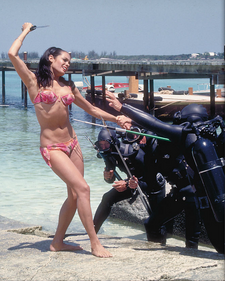
Promotional photo of Martine Beswick in Thunderball (1965).
Since teaming up with Ian Fleming, Kevin McClory had always wanted to direct the film himself; however, the agreement with EON did not allow this. Instead McClory took on the role of executive producer. Consequently, with the exception of GoldenEye (1995), Thunderball is the only official James Bond film for which Broccoli, during his lifetime, did not receive credit as producer. Initially, Broccoli turned to director Guy Hamilton, who directed Goldfinger. Hamilton turned the job down considering himself worn out and "creatively drained", although he would later return in 1971 for Diamonds Are Forever as well as Live and Let Die (1973) and The Man with the Golden Gun (1974). Terence Young, who directed the first two Bond films, Dr. No and From Russia with Love, was subsequently chosen. Coincidentally, when Saltzman invited him to direct Dr. No, Young expressed interest in directing adaptations of Dr. No, From Russia With Love and Thunderball. Years later, Young said Thunderball was filmed "at the right time", considering that if it had been the first film in the series the short budget — Dr. No cost only $1 million – wouldn't have had good results. Thunderball was the final James Bond film directed by Young.
Filming commenced on 16 February 1965, with principal photography of the opening scene in Paris. Filming then moved to the Château d'Anet, near Dreux, France for the fight in pre-credit sequence. Much of the film was shot in the Bahamas; Paradise Island in The Bahamas (where most of the footage was shot), and Miami. Huntington Hartford gave permission to shoot footage on his Paradise Island and is thanked at the end of the movie. Thunderball is widely known for its extensive underwater action scenes which are played out through much of the latter half of the film. Filming was shot at Pinewood Studios, Buckinghamshire, Silverstone racing circuit for the chase involving Count Lippe, Fiona Volpe and James Bond's Aston Martin DB5. The shooting of the chase sequence was particularly dangerous - stuntman Bob Simmons was required to blind drive Lippe's Ford Fairline using a specially constructed apparatus which allowed him to jump clear when the car left the road and exploded. However, Simmons did not signal to the crew that he was safe (partially as a prank on special effects supervisor John Stears), leading to a tense moment when the crew believed that the stunt had gone badly wrong. Footage from another camera angle was later revealed to show Simmons escaping from the car, although he was almost burned in the ensuing explosion. Terence Young later revealed he kept the cameras rolling to ensure he had captured the shot, despite the worries over Simmons' wellbeing.
On arriving in Nassau McClory searched for possible locations to shoot many of the key sequences of the film and used the home of a local millionaire couple, the Sullivans, for Largo's estate. Part of the SPECTRE underwater assault was also shot on the coastal grounds of another millionaires' home on the island. The most difficult sequences to film were the underwater action scenes and the first to be shot underwater was at a depth of 50 feet to shoot the scene where SPECTRE divers remove the atomic bombs from the sunken Vulcan bomber. Peter Lamont had previously visited a Royal Air Force bomber station carrying a concealed camera which he used to get close-up shots of the secretive missiles and those appearing in the film were not actually present. Most of the underwater scenes had to be done at lower tides due to the sharks in the Bahamian sea.
Connery's was wary of scenes involving the use of sharks, such as the scene where Bond is trapped in a shark-infested pool. He insisted that Ken Adam build a special Plexiglas partition inside the pool but, despite this, it was not a fixed structure and one of the sharks managed to pass through it; forcing Connery to abandon the pool immediately. Another dangerous situation occurred when special effects coordinator John Stears brought in a supposed dead shark carcass to be towed around the pool. The shark, however, was not dead and revived at one point. Due to the dangers on the set, stuntman Bill Cummings demanded an extra fee £250 to double for Largo's sidekick Quist as he was dropped into the pool of sharks.
The climactic underwater battle was shot at Clifton Pier and was choreographed by Hollywood expert Ricou Browning, who had worked on many films previously such as Creature From the Black Lagoon in 1954. He was responsible for the staging of the cave sequence and the battle scenes beneath the Disco Volante and called in his specialist team of divers who posed as those engaged in the onslaught. Voit provided much of the underwater gear in exchange for product placement and film tie-in merchandise. Lamar Boren, an underwater photographer, was brought in to shoot all of the sequences. United States Air Force Lieutenant-Colonel Charles Russhon, who had already helped alliance EON productions with the local authorities in Turkey for From Russia with Love (1963) and at Fort Knox for Goldfinger (1964), using his position, was able to gain access to the United States Navy's Fulton surface-to-air recovery system, used to lift Bond and Domino from the water at the end of the film. He was also able to supply the experimental rocket fuel used to destroy the Disco Volante.
While in Nassau, during the final shooting days, special effects supervisor John Stears was supplied the experimental rocket fuel to use in exploding Largo's yacht, the Disco Volante. Ignoring the true power of the volatile liquid, Stears doused the entire yacht with it, took cover, and then detonated the boat. The resultant massive explosion shattered windows along Bay Street in Nassau roughly 30 miles away. Stears went on to win an Academy Award for his work on Thunderball. Filming ceased in May 1965 and the final scene shot was the physical fight on the bridge of the Disco Volante.
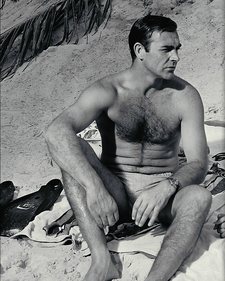
Sean Connery on the set of Thunderball (1965)
As the filming neared its conclusion, Connery had become increasingly agitated with press intrusion and was distracted with difficulties in his marriage of 32 months to actress Diane Cilento. Connery refused to speak to journalists and photographers who followed him in Nassau stating his frustration with the harassment that came with the role;
- "I find that fame tends to turn one from an actor and a human being into a piece of merchandise, a public institution. Well, I don't intend to undergo that metamorphosis."
In the end he only gave a single interview to Playboy as filming was wrapped up, and even turned down a substantial fee to appear in a promotional TV special made by Wolper Productions for NBC The Incredible World of James Bond. According to editor Peter R. Hunt, Thunderball's release was delayed for three months, from September until December 1965, after he met Arnold Picker of United Artists, and convinced him it would be impossible to edit the film to a high enough standard without the extra time.
Locations[]
Filmed in Caribbean locales, Thunderball is remarkable for its underwater scenes, which contributed greatly to the popularisation of scuba diving as recreation.
| In-Film Locations | Shooting Locations |
|---|---|
|
|
Map[]
Music[]
Main articles: Thunderball (soundtrack)
The title theme was written by John Barry and Leslie Bricusse. It was the third James Bond score composed by Barry, after From Russia With Love and Goldfinger. It was originally entitled "Mr. Kiss Kiss, Bang Bang", taken from an Italian journalist who in 1962 dubbed agent 007 as Mr. Kiss Kiss, Bang Bang. The song was originally recorded by Shirley Bassey, but was later rerecorded by Dionne Warwick, whose version was not released until the 1990s. The song was removed from the title credits after producers Albert R. Broccoli and Harry Saltzman were worried that a theme song to a James Bond film would not work well if the song did not have the title of the film in its lyrics. Barry then teamed up with lyricist Don Black and wrote "Thunderball", which was sung by Tom Jones who, according to Bond production legend, fainted in the recording booth when singing the song's final note. Jones said of it, "I closed my eyes and I held the note for so long when I opened my eyes the room was spinning." The song, Maurice Binder's titles, and the lengthy holding of the final note were parodied by Weird Al Yankovic's title sequence for Spy Hard with instrumental backing by Jimmie Haskell. Country musician Johnny Cash also submitted a song to Eon productions titled "Thunderball", but it went unused.
Legacy[]
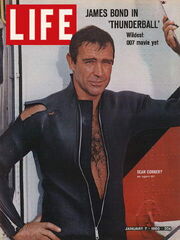
Sean Connery on the January 7, 1966 cover of Life
Thunderball's release in 1965 marks the height of what is generally referred to as "spymania" that was essentially created after the cinema success of Dr. No, From Russia with Love, and Goldfinger. Fueled by James Bond, 20 new spy films had been announced to be either in preproduction or production in 1965 and numerous successful television shows featuring similar spy elements and secret agents were just beginning, such as The Man from U.N.C.L.E., I Spy, The Wild Wild West, and Get Smart. When Thunderball was released, it became the most financially successful Bond film to date and the most successful of Sean Connery's official Bond films, taking in $141.2 million worldwide. John Cork's James Bond: The Legacy, a book about the cultural impact of James Bond states:
- "Thunderball would go on to sell over 58.1 million tickets in the U.S., which at the end of 1965 had 194.5 million inhabitants. In raw terms, this meant that statistically more than one in every four Americans paid to go and see the movie. The film became the highest-grossing hit of 1966 all over the world."
Additionally, to date, Thunderball is the only James Bond film to rank #1 on the American box office chart. With inflation taken into account, Thunderball is also the most financially successful Bond film ever. In 1966, it became the second James Bond film to be nominated and win an Academy Award. John Stears won for Best Visual Effects.
On November 20, 2005, the surviving members of the cast and crew gathered in London for a special 40th Anniversary screening.
Weapons & Gadgets[]
Gadgets[]
- Main article: List of James Bond gadgets

|
Bell Rocket Belt – After assassinating Col. Bouvar, Bond uses the jet pack to make a quick escape to the nearby DB5. |

|
Watch – A modified Breitling Top Time wristwatch, containing a built-in Geiger counter. Radiation levels are displayed via the watch's hands. |

|
Camera – In addition to taking pictures in the dark, underwater using an infared lens; it has a Geiger counter built in. Radiation levels are displayed via an audible clicking noise emitted by the camera. |

|
Rebreather – A small device that can be carried on the person without notice and when in use, is held in the mouth to provide a few minutes of air in emergencies or when the user has to go underwater. |

|
Scuba tank – During the final undersea battle, Bond is equipped with a bulky scuba tank that not only propels him through the water faster than anyone can swim, but is also armed with a missile launcher. |
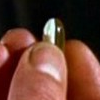
|
Homing pill – When Bond takes this pill, it emits a signal that can be detected only by a certain receiver. |

|
Tape recorder – An audio-recorder disguised as a copy of the Nassau Directory. |
Weapons[]
- Main article: List of Firearms

|
Walther PPK - James Bond's sidearm. Is also used by Count Lippe and Vargas. |

|
Beretta 950 Jetfire - used by Fiona Volpe at the hotel room, when she shows her true colors. |

|
Beretta M1934 - used by Count Lippe at Shrublands, when he attempts to kill Bond. |

|
Colt Detective Special - used by Count Lippe when chasing down Bond's DB5 before being blown up by Fiona Volpe's motorcycle. Captain of Disco Volante also carries one. |

|
Colt New Service - used by Largo's thug at the dance club scene, the thug unwittingly shoot Fiona with it and kills her. |

|
Smith & Wesson Model 10 - used by the Chateau butler |

|
Smith & Wesson Model 36 - used by Largo's thugs |

|
M1 Carbine (scoped) - Used by Felix Leiter to provided covering fire for Bond, to scare off the sharks when the latter goes to dive. |

|
Remington Model 58 - Shotgun used by Fiona at Largo's villa. |

|
Browning Auto-5 - Shotgun used by Bond at Largo's villa. |
| MP-40 - used SPECTRE henchmen at Largo's villa and Disco Volante. | |
| Sterling L2A3 - One of Emilio Largo's men is seen briefly holding one. | |

|
Browning M1919A4 |

|
Browning M2 |

|
Lahti L-39 Anti-Tank Rifle |
| Spear Gun - Used by Bond to kill Vargas. Also used by Allied Divers and Largo's Divers during the final underwater battle. |
Vehicles[]
- Main article: List of James Bond vehicles
Major vehicles[]
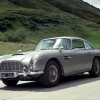
|
Aston Martin DB5 – In Thunderball, the famous Aston Martin DB5 makes its second appearance. For this film a surprise modification of rear water cannons were used in the opening pre-title sequence, although the vehicle itself has a noticeably weathered appearance that goes unexplained (perhaps suggesting other, unseen adventures or just dust and dirt raised, moments earlier, by Bond's landing with the Bell Rocket Belt). |
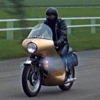
|
BSA Lightning A65L– A modified BSA Lightning motorcycle employed by SPECTRE agent, Fiona Volpe. It is equipped with forward-firing rockets and was used to assassinate Count Lippe. |
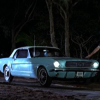
|
1965 Ford Mustang Convertible– Fiona Volpe drives a sky blue Mustang while in the Bahamas, and gives Bond a lift back to his hotel, taking the car up to 100 mph on a tree lined country road. |
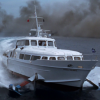
|
Disco Volante – A luxurious hydrofoil craft owned by Emilio Largo, an agent of SPECTRE . The craft plays a pivotal role in the seizure and transportation of two nuclear warheads. It is a high-tech ship that possesses a number of smaller underwater submarine craft. |
Major vehicles[]
TBA
Background vehicles[]
Background vehicles include: TBA
Trivia[]
- At the last minute, a reference to the then-recent Great British Train Robbery was inserted into the SPECTRE briefing near the beginning of the film.
- In the conference room, Agent 007 sits in the 7th chair.
- Throughout the entire film, James Bond never introduces himself as "Bond, James Bond".
- The name of Emilio Largo's yacht, the Disco Volante, means "Flying Saucer" in Italian, Portuguese, and Spanish. In the 1983 remake Never Say Never Again, Largo's ship is named the Flying Saucer.
- Some prints of this film are lacking the trademark "James Bond will return" message at the end, while others include it.
- Thunderball was delayed from an October 1965 release to December 1965. Peter Hunt stated this was due to the film running long; Variety reported the runtime to be four and half hours.
- The front cover of Thunderball's Ultimate Edition DVD is the only one in the series not to feature cropped image of Bond holding his signature Walther. Instead, he is shown wielding a spear gun.
- After the film's release, there was some confusion as to whether the "rebreather" actually existed and worked. In the real world, a rebreather could not be that small, as it would not have room for a breathing bag. It was made with two CO2 bottles glued together and painted, with a small mouthpiece attached. For this reason, when the Royal Corps of Engineers asked Peter Lamont how long a man could use the device underwater, the answer was "As long as you can hold your breath."
- While bidding farewell to Patricia Fearing before he departs for MI6 briefing in London, Bond mentions the phrase "another time, another place". This happens to be the title of the 1958 film of the same name starring Sean Connery, 4 years before his Bond debut.
- While being detained by Fiona Volpe, Bond states the actions he did were for King and Country, however this is incorrect as Queen Elizabeth II had been on the Throne since 1952 with the death of her father, King George VI.
- Another Bond film with uniformed officers with decorations. Group Captain Dawson wears the:
First row Distinguished Service Order, Distinguished Flying Cross (upside down), Air Force Cross (upside down) Second row 1939–45 Star, Air Crew Europe Star, Africa Star, Burma Star Third row Italy Star, Defence Medal, War Medal 1939–1945, Queen Elizabeth II Coronation Medal
the unnamed Air Vice-Marshal wears: First row Order of the British Empire, Distinguished Service Order, Distinguished Flying Cross (upside down) Second row 1939–45 Star, Africa Star, Italy Star, France and Germany Star, Defence Medal Third row War Medal 1939–1945, Korea Medal, United Nations Korea Medal, Queen Elizabeth II Coronation Medal, General Service Medal.
Sir John, at the Thunderball briefing, wears the uniform of an Air Marshal and: First row Order of the British Empire, Distinguished Service Order, Distinguished Flying Cross (upside down) Second row 1939–45 Star, Air Crew Europe Star, Africa Star, Burma Star Third row Defence Medal, War Medal 1939–1945, General Service Medal, Queen Elizabeth II Coronation Medal
Gallery[]
External links[]
- Thunderball (1965) at IMDb
- Official James Bond website
- MGM's official site for Thunderball
- Universal Export's entry on Thunderball
- Production notes for Thunderball — MI6.co.uk
- Thunderball — The Bond Film Informant
- "McClory, Sony and Bond: A History Lesson — Universal Exports
- Thunderball obsessional; a website devoted to all things, Thunderball
| James Bond films |
|---|
| Sean Connery Dr. No (1962) • From Russia with Love (1963) • Goldfinger (1964) • Thunderball (1965) • You Only Live Twice (1967) • Diamonds Are Forever (1971) |
| George Lazenby On Her Majesty's Secret Service (1969) |
| Roger Moore Live and Let Die (1973) • The Man with the Golden Gun (1974) • The Spy Who Loved Me (1977) • Moonraker (1979) • For Your Eyes Only (1981) • Octopussy (1983) • A View to a Kill (1985) |
| Timothy Dalton The Living Daylights (1987) • Licence to Kill (1989) |
| Pierce Brosnan GoldenEye (1995) • Tomorrow Never Dies (1997) • The World Is Not Enough (1999) • Die Another Day (2002) |
| Daniel Craig Casino Royale (2006) • Quantum of Solace (2008) • Skyfall (2012) • Spectre (2015) • No Time To Die (2021) |
| Unofficial films Casino Royale (1954) • Casino Royale (1967) • Never Say Never Again (1983) |
| All Bond films on Archive |


